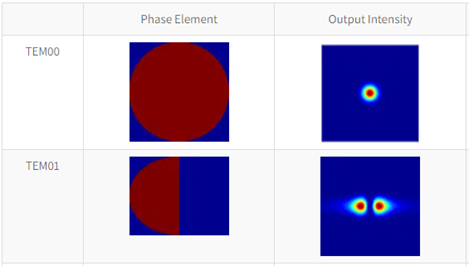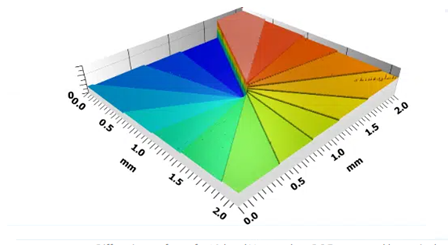Phase plate optics provide numerous uses including phase contrast microscopy, ring beam generation, and more. By manufacturing well-known phase differences in regions of the plate, many uses can be achieved.
Phase plates are a common name for many types of optical elements, designed to give a wavefront a pre-designed phase profile. This phase can be used for various light shaping applications. In this article we will detail the operating principle for phase plate optics and some of the possible application of phase plates in laser optics.
Operating principle
A wavefront passing through a transmissive material has a lower speed than a wavefront passing in air. This means that by manufacturing an optical window (a plate) with variable thickness, the wavefront at thicker areas can be delayed by a pre-designed amount relative to thinner area, with any desired profile achievable by defining the boundaries of the areas . Given the distribution of the phase, the image that is received at the far field will be given by the Fourier transform of that phase and the incoming amplitude. This means almost any image can be produced.
Types and uses of phase plates:
Mode converters
Using a phase plate with a half a cycle of delay (pi) in phase in some areas vs others, TEM00 gaussian beams can be converted into other TEM Hermite-Gaussian beams. For example, if half the beam is delayed by pi vs the other half, the mode is converted to TEM01. More information on this can be found in our information page on mode converters.

Spiral phase plates
A spiral phase plate, also known as vortex phase plate is a phase plate that gradually increases in phase from 0 to two pi in steps. The number of times the steps reach two pi is called the topological charge and is marked with ‘m’. This phase plate produces a phase vortex beam which translates to a ring or doughnut shaped beam in the image plane. This ring-shaped beam can be utilized for Stimulated Emission Depletion (STED) microscopy. This method is used to achieve super-resolution microscopy which gives resolution greater than a diffracted limited spot size, which was the prior obstacle. More on STED can be found in our article on the utilization of vortex plates for STED microscopy. Vortex phase plates can also be used the other way around, by helping analyse circular beams and determine their optical angular momentum.
Phase contrast microscope
Phase contrast microscopy, also known as a phase plate microscopy, is a method of microscopy designed to highlight contrast differences of transparent materials, such as living cells. When trying to image a transparent object, the light intensity scattered off the object is very similar to the un-scattered background light, making it hard to differentiate the two and obtain an image. However, the light scattered by the object has a small phase shift vs. the background, due to the different delay of the materials. Using a phase plate, this phase difference is turned into an intensity difference, which makes it easier to differentiate between the object and background.

TL; DR – Q&A SUMMARY
What is a phase plate?
A phase plate is an optical window designed to give a passing wavefront (beam) a known and pre-determined phase at output.
What functions and applications do phase plates have?
Phase plates have many uses, among them are mode converters, generation of vortex beams, phase contrast (phase plate) microscopy and more.
What is the use of phase plates in mode converters?
Phase plates can be used to convert TEM00 Hermite – Gaussian mode beams into other modes by giving half a cycle of delay (pi) in pre-determined, well known regions of the plate.
What is the use of vortex phase plates?
Vortex phase plates can be used to create Laguerre – gaussian ring shaped modes. These rings can be used in STED microscopy, or any other application requiring a ring-shaped beam with a sub- diffraction limit central hole.

